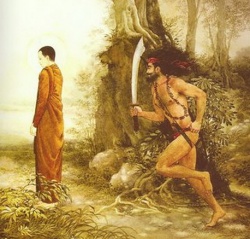Difference between revisions of "Pain"
(Created page with "thumb|250px| Pain is an unpleasant feeling often caused by intense or damaging stimuli, such as stubbing a toe, burning a finger, putting al...") |
|||
| (One intermediate revision by the same user not shown) | |||
| Line 1: | Line 1: | ||
[[File:Angulimala201.jpg|thumb|250px|]] | [[File:Angulimala201.jpg|thumb|250px|]] | ||
| − | |||
| − | [[Pain]] motivates the individual to withdraw from damaging situations, to protect a damaged body part while it heals, and to avoid similar experiences in the future Most [[pain]] resolves promptly once the [[painful]] stimulus is removed and the [[body]] has healed, but sometimes pain persists despite removal of the stimulus and apparent healing of the [[body]]; and sometimes [[pain]] arises in the absence of any detectable stimulus, damage or disease. | + | |
| + | |||
| + | |||
| + | [[Pain]] is an [[unpleasant]] [[feeling]] often [[caused]] by {{Wiki|intense}} or {{Wiki|damaging}} {{Wiki|stimuli}}, such as stubbing a toe, burning a finger, putting [[alcohol]] on a cut, and bumping the "funny bone". | ||
| + | |||
| + | The International Association for the Study of [[Pains]] widely used {{Wiki|definition}} states: | ||
| + | |||
| + | "[[Pain]] is an [[unpleasant]] sensory and [[emotional]] [[experience]] associated with {{Wiki|actual}} or {{Wiki|potential}} {{Wiki|tissue}} {{Wiki|damage}}, or described in terms of such {{Wiki|damage}}." | ||
| + | |||
| + | [[Pain]] motivates the {{Wiki|individual}} to withdraw from damaging situations, to {{Wiki|protect}} a damaged [[body]] part while it heals, and to avoid similar [[experiences]] in the {{Wiki|future}} | ||
| + | |||
| + | Most [[pain]] resolves promptly once the [[painful]] {{Wiki|stimulus}} is removed and the [[body]] has healed, | ||
| + | |||
| + | but sometimes [[pain]] {{Wiki|persists}} despite removal of the {{Wiki|stimulus}} and apparent [[healing]] of the [[body]]; | ||
| + | |||
| + | and sometimes [[pain]] arises in the absence of any detectable {{Wiki|stimulus}}, {{Wiki|damage}} or {{Wiki|disease}}. | ||
{{W}} | {{W}} | ||
[[Category:Buddhist Terms]] | [[Category:Buddhist Terms]] | ||
Latest revision as of 11:03, 27 February 2016
Pain is an unpleasant feeling often caused by intense or damaging stimuli, such as stubbing a toe, burning a finger, putting alcohol on a cut, and bumping the "funny bone".
The International Association for the Study of Pains widely used definition states:
"Pain is an unpleasant sensory and emotional experience associated with actual or potential tissue damage, or described in terms of such damage."
Pain motivates the individual to withdraw from damaging situations, to protect a damaged body part while it heals, and to avoid similar experiences in the future
Most pain resolves promptly once the painful stimulus is removed and the body has healed,
but sometimes pain persists despite removal of the stimulus and apparent healing of the body;
and sometimes pain arises in the absence of any detectable stimulus, damage or disease.
